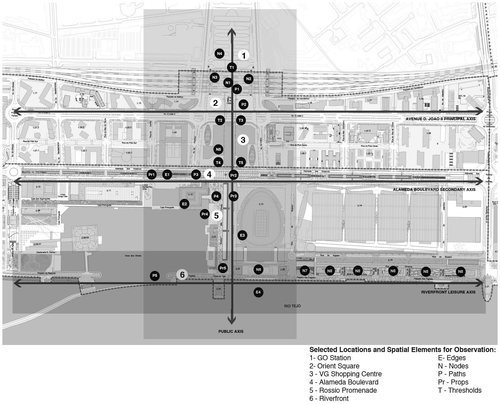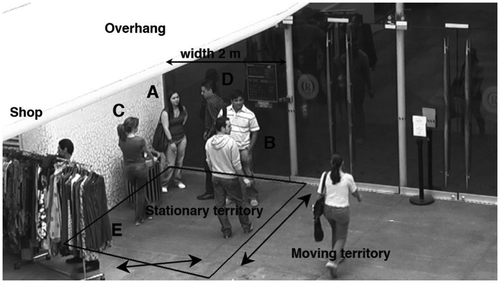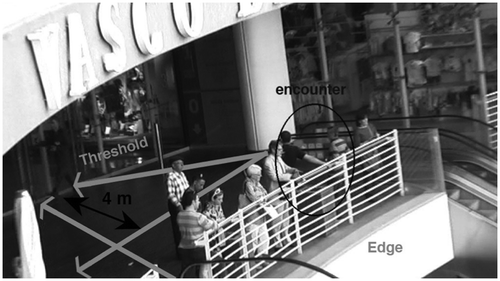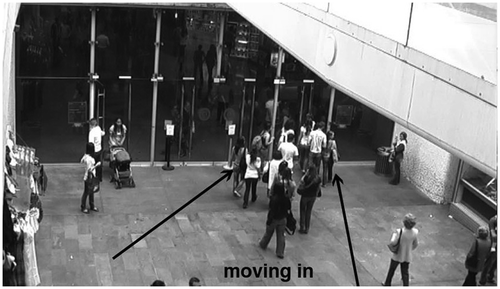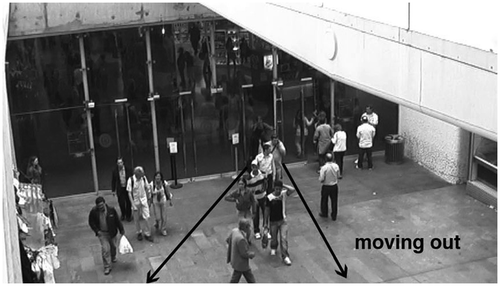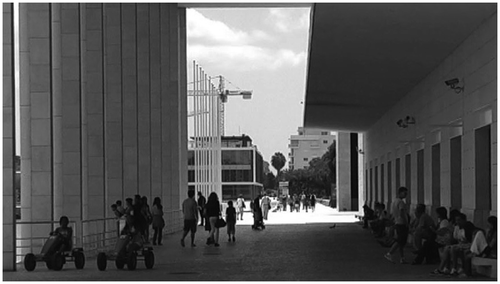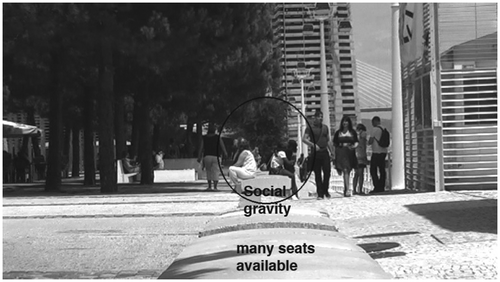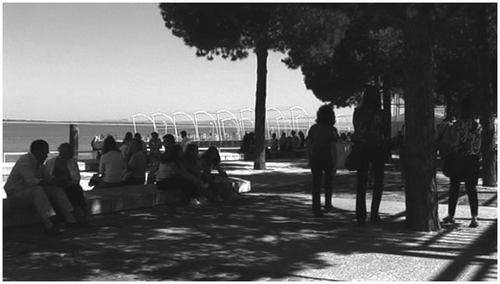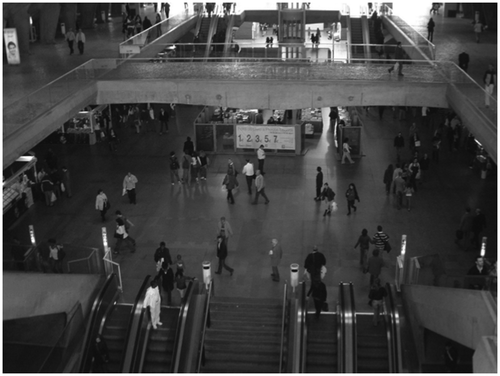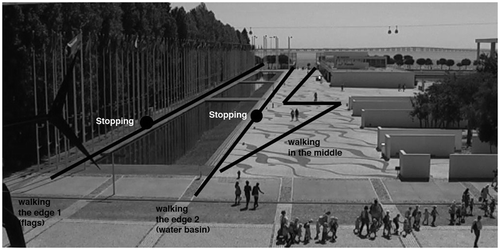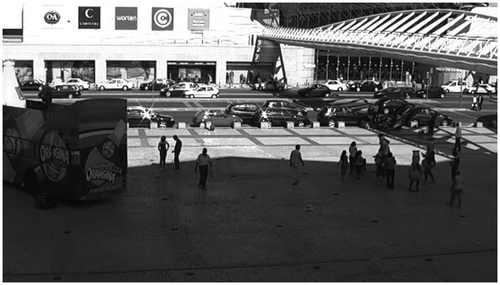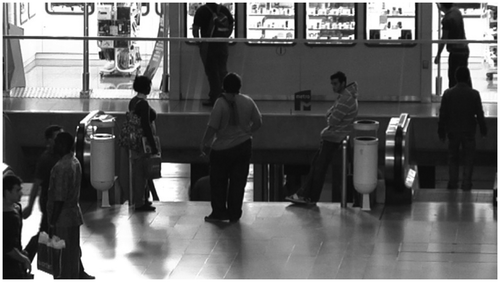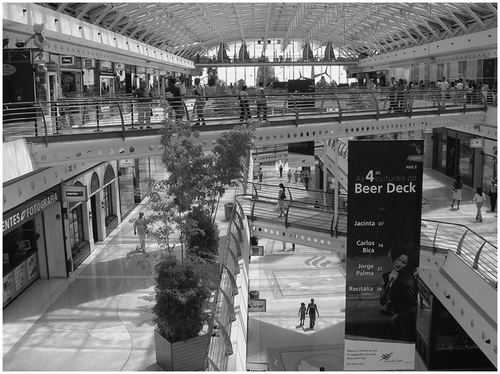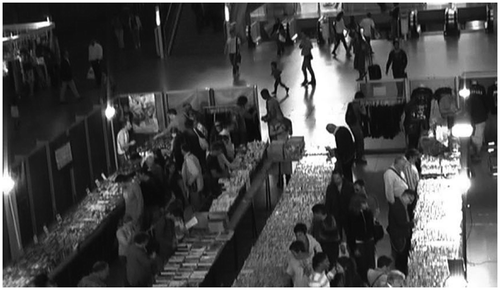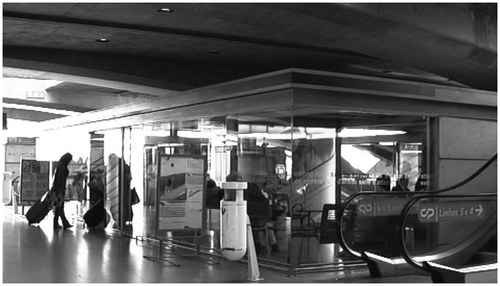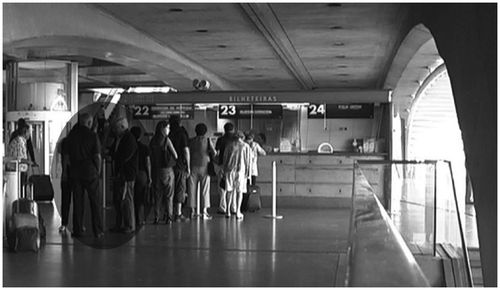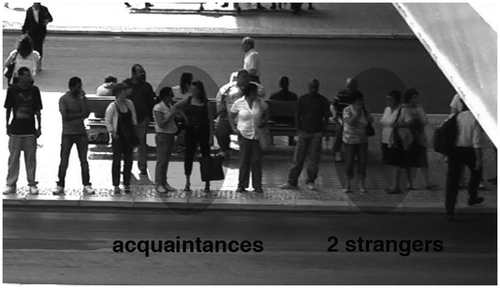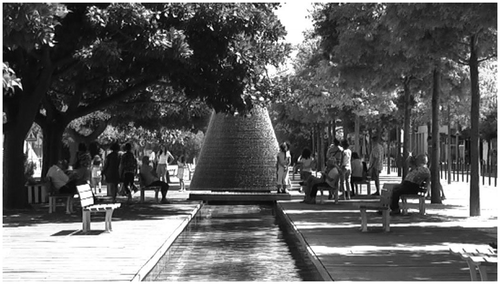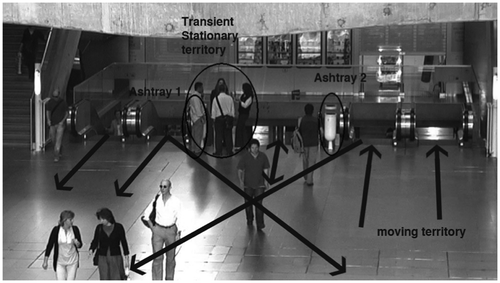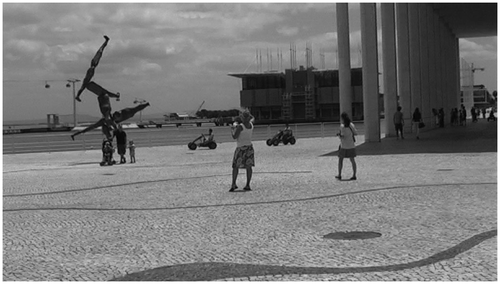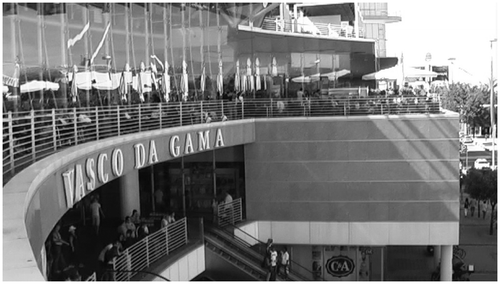Abstract
This paper introduces ‘fourth places’ as an additional category of informal social settings alongside ‘third places’. Through extensive empirical fieldwork on where and how social interaction among strangers occurs in the public and semi-public spaces of a contemporary masterplanned neighbourhood, this paper reveals that ‘fourth places’ are closely related to ‘third places’ in terms of social and behavioural characteristics, involving a radical departure from the routines of home and work, inclusivity and social comfort. However, the activities, users, locations and spatial conditions that support them are very different. They are characterized by ‘in-betweenness’ in terms of spaces, activities, time and management, as well as a great sense of publicness. This paper will demonstrate that the latter conditions are effective in breaking the ‘placelessness’ and ‘fortress’ designs of newly designed urban public spaces and that, by doing so, they make ‘fourth places’ sociologically more open in order to bring strangers together. The recognition of these findings problematizes well-established urban design theories and redefines several spatial concepts for designing public space. Ultimately, the findings also bring optimism to urban design practice, offering new insights into how to design more lively and inclusive public spaces.
Introduction
There is a growing belief that living with diversity is beneficial for social cohesion. To attest this, one just has to look to the great amount of research produced that focuses on the different ways that it can be achieved. Most of this research is strongly influenced by North American academic literature on social caital, namely that of Robert Putnam, who advocates that everyday social contact and encounters are crucial to overcome ethnic cultural differences. There is a shared consensus that interactions among strangers are positive for building community cohesion. Notwithstanding this consensus, it is interesting to note that most of this research has not yet come to terms with what is really meant by ‘meaningful interactions’ and how they can be achieved (Amin Citation2002; ; DCLG Citation2008; Lownsbrough and Beunderman Citation2007; Tunstall and Fenton Citation2006). On the one hand, national governments are tackling social cohesion with increasing regulation, surveillance and control by getting tougher on crime, minorities, youth and asylum seekers, especially after 9/11 and the riots in the UK. On the other hand, local governments have been establishing meaningful interaction as one of the national targets linked to cohesion.
Despite these divergent ideas, there is a growing belief that coming to terms with difference demands a regularity of encounter between strangers, and that our public spaces play an important role in achieving it. This belief is visible in the focus of many city policy agendas towards the making of mixed housing communities and inclusive town centres, but also in the increasing investment in government funded and academic research to identify the potential contact spaces and desirable qualities that support positive social interactions (Holland et al. Citation2007; Home Office Citation2001; Lownsbrough, and Beunderman Citation2007).
However, most of the current policy and research agendas have limitations. First, those policy agendas fail to recognize the complexities of interactions, the multiplicity of users and needs (Amin Citation2010). Regulating through tough discipline and control is not the only solution to deal with negative interactions; neither is social mixing always a successful way to promote positive interactions (Amin Citation2010). Second, most of the current government funded research is very much hands-on practice and focuses more on the social than the spatial attributes of public spaces, e.g. focusing on strategies such as temporary uses and events that can enliven public spaces and contribute to building social bonds (Demos 2007). The academic research usually suffers from a divide between sociological and urban design scholarship. It either only addresses the macro-sociological aspects of public life (Shields Citation1992; Castells et al. Citation2001; Hajer and Reijndorp Citation2001; Sheller and Urry Citation2003) or only focuses on the production of urban spaces (Flusty Citation1997; Loukaitou-Sideris and Banerjee Citation1998; Németh and Schmidt Citation2011). This is not to say that there are no exceptions, because there are, but they are fairly limited to the 1970s and 1980s. During this period several authors brought urban design closer to the field of scholarship of environment behavioural studies to explore the social dimension of urban design. This is particularly the case with the seminal works of Gehl (Citation1971), Alexander et al. (Citation1977), Joardar and Neill (Citation1978) and Whyte (Citation1980). Although it must be acknowledged that some of this research recently regained momentum with the work of Marcus and Francis (Citation1990), Kaplan, Kaplan and Ryan (Citation1998), Mark Childs (Citation2004), Franck and Stevens (Citation2007), Stevens (Citation2006a, Citation2007) and Mehta (Citation2007, Citation2013); Mehta and Bossom (Citation2010), none of these were specifically focused on social interactions in public space per se. Notwithstanding these limitations, a solid body of knowledge was gained about sociability in public spaces and the role of urban design in it. We also have a greater understanding of the key design characteristics that support social behaviour in a wide range of types of spaces ‒ from the traditional public spaces such as streets and squares to ‘third places’ such as private businesses of cafés, shops and all other informal gathering spaces in the city, including street intersections, stoops, edge spaces, bus stops and waiting spaces. However, despite all this knowledge, the sociability of the newly designed public and privately owned and managed spaces has not yet been fully addressed. Instead, these spaces have frequently been blamed for the decline of the public realm (often with little empirical evidence) for being not only bland and placeless but also socially alienating and highly exclusionary, due to their excessive reliance on privatization, control or themed designs (Sommer Citation1974; Relph Citation1976; Sorkin Citation1992; Shaftoe Citation2008). Thus, if we want to do justice to these spaces, we need to test these critiques. All this research also misses a deeper understanding of the micro-sociology of the spaces studied, namely the complex social mechanics between people and space and the micro-design characteristics that might encourage or constrain their social interactions.
This paper aims to address this knowledge gap on the social dimension of urban design. To do so, it brings closer the two bodies of knowledge from urban design and sociology by integrating theories and methods from both. It also aims to offer a deeper understanding of the social performance of these newly designed public and semi-public spaces.
This paper presents extensive empirical fieldwork on informal public social life, focusing on the social interactions among strangers in the public spaces of the Park of the Nations, a new masterplanned neighbourhood in Lisbon, Portugal. This neighbourhood is a good illustration of current planning and urban design trends and critiques. It is characterized by large scale, highly controlled and thematic public spaces, and it reflects the new principles of urban compactness and diversity advocated by Jane Jacobs (Citation1961).
The findings presented in this paper offer a renewed understanding about the everyday sites of social interaction. They demonstrate that informal public social interaction still occurs in newly designed public and semi-public spaces. However, the types of spatial settings and conditions in which interaction occurs do not conform to the traditional definitions of public life and public space. Spatial, temporal or managerial ‘in-betweenness’ and a great sense of publicness characterize these types of settings. Many of these spaces and conditions were acknowledged and theorized before as favourable spaces and conditions that support informal social life ‒ thresholds and edge spaces, and the conditions of ‘open regions’ (Goffman Citation1963), ‘people-watching’ (Lofland Citation1998), ‘events’ (Goffman Citation1963; Lofland Citation1998) and ‘triangulation’ (Whyte Citation1980). These spaces and conditions are often assumed to have arisen primarily from social conditions rather than physical ones, because they have been mainly theorized by sociologists. However, the findings of this paper also reveal that these conditions are strongly spatialized. They occur in very specific spatial settings and under particular spatial conditions.
This paper also identifies other spaces and conditions that are still under-theorized or have not yet been accepted in social and urban design theories as favourable spaces for informal social life. This is the case with circulation, controlled and congested spaces and conditions. In contrast to the previously mentioned conditions, these are primarily spatial ‒ indeed, they originate from major urban design critiques. However, they also illustrate some of the social potential of newly designed public spaces, showing that they are not always deterministic designs, since people still have a choice over whether to interact or not.
Overall, this paper argues that these spaces and conditions constitute a distinctive set of informal social settings, alongside the other three realms of social life ‒ home, work and ‘third places’. This paper calls these spaces ‘fourth places’ because they are a type of informal social space closely related to ‘third places’ in terms of social and behavioural characteristics, in their differentiation from the routines of work or home and in their inclusivity. However, in all other aspects, they are very distinct ‒ they are more mixed relational locales, whilst their locations, activities and spatial conditions are characterized by ‘in-betweenness’ and great publicness.
The recognition of ‘fourth places’ as informal social settings leaves ground for optimism about newly designed public and semi-public spaces. It shows that they are not necessarily dead and rigid but can still be reshaped by their users and generate new meanings and uses.
In the following pages this paper will demonstrate that the two themes of ‘in-betweenness’ and publicness that characterize ‘fourth places’ illustrate a range of ways in which urban design can break the seemingly ‘placelessness’ and ‘fortress designs’ of new urban public spaces. It will argue that by allowing ‘in-betweenness’, by leaving certain spaces undefined, empty or under-programmed, new uses can be filled in. In addition, it will also show that through a good level of spatial novelty and complexity these spaces can allow a great sense of publicness, and thereby become sociologically more open to a diversity of users. Their novelty is the outcome of an unprecedented new generation of emerging typologies, designs and building practices, while their complexity is the result of design diversity and indeterminacy.
This paper starts by examining existing literature from urban sociology and urban design, to frame the main patterns and specific changes in urban social life in relation to the processes of production of public spaces. Then, drawing on these two bodies of knowledge, a conceptual framework to study the sociality and spatiality of informal public social interaction is proposed. Subsequently, the fieldwork findings are presented and linked back to existing theories. Finally, the implications of the findings for urban design theory and practice are discussed. The ultimate aim of this paper is to develop a better informed behavioural-centred approach in urban design and use the knowledge gained to inform both theory and practice. The designers are the ones who will benefit most from this knowledge because they are often ill equipped to evaluate the social impact of their design outcomes (Marshall Citation2012). Therefore, this paper wants to offer them more effective methods and theories to gain a deeper understanding of the social performance of the public spaces they design, and by doing so, to help them in designing more inclusive and socially fit public spaces in the future.
Literature on the public realm
Urban sociology has explored fairly well the attitudes which society holds towards the public realm. It has helped to uncover the main patterns, changes and unresolved conflicts about public social life. An overview of these theories shows a tendency of social scientists to depict views of public social life and public space as extremely polarized between negative and positive. The negative views started with early twentieth-century authors such as Simmel (Citation1903) and Wirth (Citation1938) arguing that public life was in decline due to social over-stimulation resulting from a large, dense and heterogeneous population. These negatives continue today but for other reasons. Authors such as Sennett (Citation1977) and Oldenburg (Citation1989) also see a decline, but more as the result of spatial under-stimulation as cities become dull, meaningless and lack appropriate social spaces.
By way of contrast, Sola-Morales (Citation1992), Shields (Citation1992), Maffesoli (Citation1996), Putnam (Citation2000), Hajer and Reijndorp (Citation2001), Castells et al. (Citation2001), and Sheller and Urry (Citation2003) take a more positive stance towards public life. They force us to look to the new communities, increasingly mobile forms of socialization and settings that are not public in the true sense but that over time have become positively valued as public realms, e.g. stations, shopping malls or amusement parks.
These divergent theories are the result of applying different concepts and models for defining what is public life and space. On the one hand, the former theories that consider that public life and public space are in decline are still guided by traditional ideals of small homogeneous communities and uncommodified inclusive public spaces (Madanipour Citation2003; Varna and Tiesdell Citation2010). They theorize public and private as two different realms connected to different kinds of spaces. They also assume that the mixing of the two in these new semi-public spaces represents a loss of authenticity. On the other hand, the latter more positive theories understand that these changes offer a plurality of social arenas and thus more freedom of choice. As a result, these theorists propose a redefinition of our traditional notions of public, speaking instead of blurred public-private realms, multiple publics and various degrees of publicness.
Although these conflicts remain unresolved, it seems clear that to engage more productively with these debates, it is no longer possible to focus only on the traditional types of public space. These new settings of consumption, mobility and recreation, although not truly public, can also offer hypotheses for consideration. However, these social theories also have shortcomings. They show little knowledge about how these issues of social life connect with urban design.
Similarly to the sociological theories, the discussions in the urban design field are also divided into narratives of loss and hope. Some authors condemn the production of the built environment of the last 50 years ‒ increasing urban sprawl, suburbanization and privatization ‒ for contributing to physical fragmentation, social segregation and loss of public realm (Relph Citation1987; Low Citation2006). Others celebrate the great investment in terms of comfort, efficiency and safety (Hajer and Reijndorp Citation2001). However, the debate that raises most contradictions and critiques is the production of newly designed public and semi-public spaces and masterplanned environments (Cybriwsky Citation1999; Lofland Citation1998). Headlines in the literature, in particular in North America, about these environments are often dystopic, declaring the ‘end of public space’ (Banerjee Citation2001). ‘Fortress’ and ‘panoptic city’, ‘theme park’ and ‘modern placelessness’ are often the terms used to describe these design trends (Relph Citation1976; Davis Citation1990; Sorkin Citation1992).
Unlike sociology, urban design still lacks a thorough theorization of urban social life, although it increasingly acknowledges its importance, which is particularly the case with work that adopts a more user and behavioural-centred approach (Marshall Citation2012; Southworth et al. Citation2012). However, despite this shortcoming, urban design literature provides a good basis for understanding the tensions, benefits and disadvantages surrounding these contemporary urban design trends.
The literature on control of public spaces shows that control is a double-edged issue. On the one hand, for many people the presence of control is a necessary precondition to feeling safer in public (Tiesdell and Oc Citation1998). On the other hand, control can sometimes be oppressive if more explicit and hard types of control are used ‒ physical segregation, target hardening and access control (Sorkin Citation1992; Flusty Citation1997). However, some types of soft control can be less visually explicit and fairly user-friendly (Tiesdell and Oc Citation1998; Németh and Schmidt Citation2011), for example, some ‘theme park’ designs achieve a good balance between control and use through their design and imagery, casting doubt on their critiques and asking us to further analyze this type of space (Boddy Citation1992; Boyer Citation1992; Crawford Citation1992; McNamara Citation1999; Sircus Citation2007).
For many authors, the legacy of the Modern Movement in architecture and planning is the other contributor to a sense of ‘placelessness’ in cities. Its legacy is visible in many urban renewal projects implemented during the 1950s and 1960s, from housing to offices and institutional complexes, and continues to inspire recent urban regeneration projects (Cybriwsky 1999) which still adopt modernist design features: large scale, non-contextual, rational order, movement and hardness (Relph Citation1987).
Since the 1970s these modernist developments have been the subject of much heated debate in the fields of planning, geography and environmental psychology, with suggestions of a strong link between modernist design and antisocial behaviour (Sommer Citation1974; Relph Citation1987). However, more recent literature offers a more nuanced perspective showing that we also have to take into account their positive sides (Whyte Citation1988; Gordon Citation1996; Talen Citation2005). Some of these projects have made positive contributions to their local economy and brought about significant design innovations. The recognition of their successes forces us to further examine such spaces. Hence, a good case study must act as a means to test out both these critiques and counter-critiques.
Conceptual framework
To investigate where and how public social interaction occurs within public spaces, this paper is supported by a conceptual framework that combines the two bodies of work of sociology and urban design. The knowledge of sociology provided by both macro- (Sennett Citation1977; Oldenburg Citation1989, among other authors) and micro-sociology (Hall Citation1969; Fast Citation1971; Scheflen Citation1972; Goffman Citation1963, Citation1983; Karp, Allen, and Yoels Citation1991; Lofland Citation1998) offers an understanding of the nature of social interactions among strangers and the available methods for studying them. The urban design theory, primarily based on the work of Lynch (Citation1960), Gehl (Citation1971), Alexander et al. (Citation1977), Whyte (Citation1980), and Stevens (Citation2006a, Citation2007), provides knowledge about the essential spatial characteristics of public social settings and the methods for analyzing their physical space. This framework allows focused attention during fieldwork on the specific locations and conditions of the studied interactions.
Informal public social interaction
The focus on social interactions among unknown strangers in public spaces has several advantages. First, unknown strangers share no history with one another and their encounters are by nature unplanned and risky ‒ they are very dependent on the spatial and social context (e.g. rules of behaviour and type of users) providing an understanding of the qualities that support social use (Goffman Citation1963). Second, their relations are more bodily than verbal, (Scheflen Citation1972), thereby offering good criteria to evaluate how space works in mechanical terms and to examine the limits and opportunities of the urban plans.
This paper does not advocate any ideal type of social interaction. It only presupposes that an inclusive and lively public realm is the place where people are brought together without fear of the stranger (Sennett Citation1977; Amin Citation2010). Hence, it does not exclude any type of interaction, even if more routinized, standardized or brief, which are more frequent, as they may also have the potential to evolve into something more significant and long-lasting (Goffman Citation1963; Milgram Citation2010). It also does not ignore that the public realm is also populated by other types of strangersFootnote1 and social realmsFootnote2, both private and parochial (Lofland Citation1998) (see Table ).
Table 1. Types of strangers, their social relations and behaviours.
Informal public social settings and their spatial characteristics
In most Western cultures, it is commonplace to have some locations traditionally associated with informal social interaction. The concept of ‘open regions’ was the first to be introduced to describe these types of place (Goffman Citation1963). Many other subsequent concepts are extensions ‒ ‘mixed locales’ (Lofland Citation1998) and ‘third places’ (Oldenburg Citation1989), or variations ‒ ‘liminal spaces’ (Shields Citation1991; Zukin Citation1991) and ‘loose spaces’ (Franck and Stevens Citation2007). Although they have differences, they have many common social characteristics, e.g. a radical departure from home and work routines and suspension of behavioural norms, inclusivity and social comfort, that welcome a wide spectrum of users. Associated with these characteristics are often certain spatial features, for example: diminished visibility (e.g. bars) facilitates informal uses (Cavan Citation1966; Oldenburg Citation1989); high visibility (e.g. cafés) can welcome particular users such as women and children (Laurier and Philo Citation2005); ‘in-betweenness’ in terms of behaviours and functions facilitates variety and adaptability of uses at different times (Goffman Citation1963; Franck and Stevens Citation2007).
The literature also identifies a few additional social conditions that can suspend social norms and make a place ‘looser’: ‘triangulation’Footnote3 (Whyte Citation1980), the presence of ‘open persons’,Footnote4 the occurrence of extraordinary eventsFootnote5 and the availability of ‘time out’Footnote6 (Goffman Citation1963; Cavan Citation1966; Lofland Citation1998).
In sum, the literature shows that, although there is no ideal type of informal social setting, a setting must have a number of essential conditions to facilitate interactions among strangers.
Urban design literature has also suggested spaces, activities and conditions that are effective in anchoring social activities ‒ spaces for stationary activities: sitting, standing, waiting and ‘people-watching’; and favourable spatial conditions, e.g. ‘people-watching’ is usually associated with places with a theatre setting layout, a well-defined stage and audience (Gehl Citation1971; Alexander et al. Citation1977; Whyte Citation1980; Bentley et al. Citation1985; Shaftoe Citation2008).
Overall, all the above literature provides a good starting point for this study. However, it also raises a series of questions.
| - | Can these favourable social conditions such as ‘open regions’, ‘triangulation’ and events also be framed by the specific spatial conditions of their locations? | ||||
| - | Do different user groups have different needs and expectations when selecting their social spaces? | ||||
Methods
A review of existing empirical methods reveals that to study such complex types of social interactions, a cross-disciplinary combination of different types of method is necessary (Low, Taplin, and Scheld Citation2005): observationsFootnote7 to identify the actual patterns of use and behaviour in the selected locations; various ethnographic interviewing methodsFootnote8 to collect detailed descriptions about the interviewee’s social interactions; spatial analysis to examine the spatial conditions; and body language methods to analyze the spatiality of these interactions, focusing on three indicators of degree of social involvement: body orientation, tie-signs and social distance (Hall Citation1969; Sommer Citation1969; Scheflen Citation1972). This combination of methods is highly innovative. The author found no evidence in the review of the literature of previous use of this combination of methods in urban design.
Case study
This paper selected as a case study the Park of the Nations (PN) in Lisbon, a new large-scale masterplanned neighbourhoodFootnote9 built for the World Expo ’98 in a former harbour and industrial area (Figure ). Besides being socially and geographically part of a Southern European culture with which the researcher is familiar, it is a good illustration of contemporary urban design trends and critiques. It follows the values of vibrant city neighbourhoods (Jacobs Citation1961), with a mixed-use centre and two dense but predominantly residential areas, but its public spaces have been criticized for their newness, large scale, control and themed designs. However, the PN is very much appreciated by its visitors, workers and residents (Interview with the editor of local newspaper “Noticias Do Parque” 2010). It offers a variety of newly designed spaces and amenities: a riverfront of 5 km in length, green spaces, public art, playgrounds for children, and spaces for outdoor sports.
Figure 1. Aerial picture of the PN on the north-eastern side of Lisbon’s harbour. Source: Abilio Leitão, Archives of Parque Expo. SA (1999).
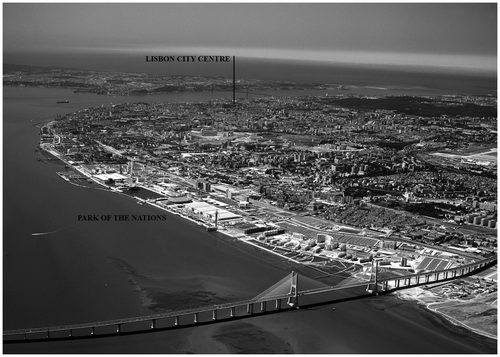
Selected studied area, times, locations and spatial elements for observation
Because the interest of this study is in informal public interaction, the study area was confined only to the public realm, the mixed-use centre where the full diversity of everyday social life and users are concentrated and where the main public and semi-public spaces, retail and services are located (Figure ). This central territory covers only 2 km in length, enabling easier exploration on foot.
Figure 2. The Public Realm of the PN. Source: drawing by the author, based on a map from Archives of Parque Expo. SA (1999).
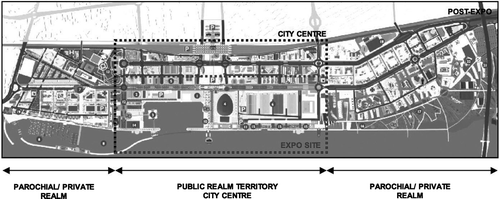
In order to collect a large opportunity sample of instances of informal social interactions, this study was undertaken over two years from December 2008 to December 2010 and revisited in 2012 (Table ). It focused mainly on locations along the two major axes of public life and leisure, with considerable criss-crossing of optional and stationary activities, a variety of public-private interface spaces: Oriente station, Oriente Square, Vasco Gama Shopping Centre, Rossio dos Olivais Promenade and Riverfront,Footnote10 and a great diversity of users (Figure ).
Table 2. Selected times for observation.
‘Fourth places’
Fieldwork contributed several findings which demonstrated that informal public socialization still occurs in newly designed public and semi-public spaces. Instead of confirming the failure of traditional public spaces, such as streets and squares in the city, these findings suggest that fresh attention should be given to the existence of another category of informal social settings alongside the three realms of social life ‒ home, work and ‘third places’. Most of these settings have already been acknowledged as essential locations that structure social behaviour in public spaces (Gehl Citation1971; Whyte Citation1980; Stevens Citation2006a). However, their micro-social characteristics specifically related with social interaction among strangers have never been studied in great detail, leaving many questions unanswered on how urban design could encourage such social interactions.
This paper calls this category of informal social settings ‘fourth places’, because most of their characteristics are closely related to the concept of ‘third places’ of Oldenburg (Citation1989) (Table ). Just like ‘third places’, ‘fourth places’ are a type of informal social space with similar social and behavioural characteristics, differentiation from work or home routines and inclusivity. Yet their types of users, activities, locations and spatial conditions are very different. ‘Fourth places’ are more mixed relational locales, more socially diverse in terms of user groups and social relations and realms, than ‘third places’ that mainly cater for parochial life among socially homogeneous groups. While in ‘third places’ conversation is the primary activity, in ‘fourth places’ it is all activities in-between necessary activities: ‘people-watching’, walking, waiting and ‘killing time’.Footnote11 But what distinguishes ‘fourth places’ the most are their location and character. Their most distinct characteristic is their spatial, temporal and managerial ‘in-betweenness’. They are not spatial or functionally distinct as are ‘third places’, which are often limited to the type of businesses such as cafés or shops, but rather the type of spaces in-between definitions and functions, e.g. intermediate and leftover spaces. Their other key characteristic is publicness. As opposed to ‘third places’ that are only privately owned and partially publicly accessible, ‘fourth places’ have a truly public and anonymous character. However, their publicness cannot be understood along the lines of ownership and accessibility alone ‒ most of them are publicly accessible privately owned and managed spaces ‒ but instead in terms of spatial conditions such as novelty and complexity. These conditions are key to making ‘fourth places’ sociologically more open and to encouraging interaction among a diverse set of users. Furthermore, they constitute a great departure from the old nostalgic look and homely character of ‘third places’ determined by a regular clientèle.
Table 3. List of characteristics of ‘third places’ and ‘fourth places’.
Spatial, temporal and managerial ‘in-betweenness’
‘In-betweenness’ is a key feature of ‘fourth places’ and, as observed, an important precondition to developing informal social use. Most of the locations that are conducive for meetings with strangers are in-between spaces, definitions and functions, such as thresholds, edge spaces, paths, nodes and props. This condition of spatial ‘in-betweenness’ is made possible because of special spatial characteristics: indeterminacy of form and function, flexibility and adaptability of uses.
Many of these in-between spaces can also frame situations of temporal ‘in-betweenness’ where unplanned uses can develop outside or in-between the times of planned uses for these spaces. Two situations where temporal ‘in-betweenness’ is perceived as legitimate are events and positive human congestion. Both situations can be powerful tools to change the planned character and use of everyday public settings during temporary time periods. They can also introduce a convivial and ‘time-out’ mood, which adds extra liveliness to the place and creates additional possibilities for unplanned spontaneous uses and social contact.
Some in-between spaces may also have an extra condition of managerial ‘in-betweenness’, i.e. overlap of different regimes of control and access. This condition stimulates constant negotiation and creative appropriation among the users of these spaces. This is especially true of spaces where the rules of behaviour and access become blurred and uncertain, e.g. thresholds in-between the two realms of private and public, and spaces where different mechanisms of spatial control are used, such as the Shopping Centre and the station.
Thresholds
Thresholds are commonly perceived as transitional spaces between public and private spaces (Norberg-Schulz Citation1971; Hillier and Hanson Citation1984; Bobic Citation2004). Whyte (Citation1980) and Stevens (Citation2006a, Citation2007) also acknowledged that thresholds are special boundaries with considerable behavioural potential. Both of them theorized thresholds as potential contact spaces where strangers are gathered by necessity when moving through them and are forced into close proximity. However, neither of them studied in detail the micro-spatial and social characteristics of thresholds that frame such encounters among strangers. This research identified many ways in which thresholds can create optimal social conditions to bring strangers together. Thresholds have special conditions of spatial and managerial ‘in-betweenness’ that offer a great deal of social comfort and thus make them suitable places for many types of ‘time-out’ activity and ‘triangulation’. If they accommodate enough space and amenities around them, they can become the most popular locations for optional and social activities that are often unusual for this type of space (Table ). This is particularly true of the thresholds of the Shopping Centre. They are the preferred hangouts for a variety of users, although at different hours. The busiest thresholds facing the station attract workers for short ‘time-out’ breaks because they offer at least 2 m of territory for stationary activities and certain amenities ‒ ashtrays and activities such as cafés and shops (Figure ). The thresholds facing the park are for longer ‘time-out’ breaks. They offer more comfort, such as a good 4 m of territory for stationary activities ‒ seating spaces and sunshade areas (Figure ). Youngsters like to congregate in them after lunch or school. Occasionally, they also attract other less regular users ‒ passers-by, shoppers and visitors ‒ that come there to rest.
Table 4. Frequency of observations of social encounters at thresholds.
The best thresholds for ‘triangulation’ are the settings that have a clear ‘stage-audience’ relationship, a clear orientation of their edges for the audience towards the threshold as stage (Figure ).
The blurring of tight and ‘loose’ regimes of behaviour is also seen to frame a variety of encounters among strangers at threshold spaces. The most frequent are moving encounters when people cross the thresholds (Figures and ). They are the result of high spatial visibility in all directions and territorial indeterminacy. High visibility provides safety for people to be among strangers. Indeterminacy of territory makes it easier for strangers to start and break off any conversation.
Edges
Edges are usually defined as a type of boundary that has a function of dividing and structuring the inside and outside (Bentley et al. Citation1985; Davies Citation2000; Shaftoe Citation2008). Yet, according to the sociologist De Jonge (Citation1967), besides structuring our physical world, edges also structure social behaviour, offering refuge and comfort. When people are in a public space they tend to sit first at the edges of that space. He theorized this phenomenon as the ‘edge-effect’. However, the empirical findings showed that edges could fulfil many other social uses and attract a variety of users (Table ). They can become the best spaces of retreat, fulfilling the desire for privacy, if they are of the type of passive edge (e.g. water or green spaces) or enclosed building or seating edge (e.g. with closed backs, L- and U-shaped benches) where people can just rest and contemplate. These are usually the preferred edges for ‘withs’Footnote12 and couples. They can also be the favourite spaces of encounter when providing increased opportunities for social interaction with strangers. For some people, especially elderly people, certain edge spaces offer the best conditions with which to participate safely in the public life of the street, e.g. elevated terraces offer good vantage points if they have the right orientation and height to ‘people-watch’ (Figure ). For young people, edge spaces are often the best spaces to test their social identity because engagement with strangers becomes less risky. This is particularly true of seating edges ‒ benches and arcades ‒ which strike a good balance between exposure and comfort (Figure ).
Table 5. Frequency of observations of social encounters at edges.
Finally, edges can also provide appropriate contexts for different levels of social mixing for a wide range of people. When people, particularly alone, search for passive mixing to be among other people without interacting, they look for more open building or seating edges with less defined territories, in-between contrasting behavioural areas, e.g. quiet and busy (Figure ). In these types of edge, people will not interact, despite feeling comfortable sharing the same space.
When people are open to active mixing ‒ to having verbal social interactions ‒ they look for very public, central and accessible edge contexts with many activity edges (e.g. cafés), a variety of seating possibilities and diminished visibility (e.g. shadow) (Figure ). These ‘edges’ features provide a good balance of exposure and comfort, which is optimal for social mixing.
Paths
Alexander et al. (Citation1977) and Whyte (Citation1980) were among the first authors to recognize the social potential of pedestrian-friendly paths, such as streets, promenades and ‘passeos’, and to describe them as important centres of urban life that can fulfil the need for human mixing, to watch and to be watched.
This research identified that paths designed with a reductive sense of purpose such as circulation spaces ‒ meant only for walking, in noisy locations, or badly equipped in terms of amenities ‒ could also offer great scope for social interaction. They could frame various types of encounter among people moving and even anchor social activities (Table ). It was identified that their scope for interaction is more dependent on their spatial conditions ‒ spatial layout, spatial variety and detail, large scale and openness ‒ than on their location and provision of amenities, as Alexander et al. (Citation1977) theorized.
Table 6. Frequency of observations of social encounters at paths.
If paths provide a spatial layout that centres or channels people’s movement, by concentrating activities and reducing the number of accesses, as does the station’s atrium (Figure ), they are likely to increase the number of intersections of pathways and the number of opportunities for spontaneous social contact such as unplanned meetings and chance encounters.
If paths offer spatial, behavioural and sensorial variation, in terms of enclosure and width, types of encounter and vistas, as does Rossio Promenade (Figure ), they can become preferred spaces for strolling and ‘people-watching’. These are powerful strategies to slow down the walking pace and attract a great diversity of users.
Large-scale and open paths may have their usual problems; they often feel deserted, because they take longer to fill up (Alexander et al. Citation1977). But at the same time they can offer more possibilities to be retrofitted to new uses that can anchor optional and social activities. In the station and Oriente Square (Figure ), the provision of large-scale open spaces allows accommodation of competing activities ‒ planned and unplanned ‒ with less conflict, such as temporary events, fairs or vendors along or in the middle of main pathways.
Nodes
Nodes are referred to in the urban design literature as strategic behavioural points and decision points of entrance or departure (Lynch 1960). However, this emphasizes their perceptual importance more than their social potential. Fieldwork revealed that it is precisely because of their spatial ‘in-betweenness’ that spatial nodes can become memorable and attract great social gravity. Yet they only become true social nodes when people use them for stationary and social activities (Table ). For this to occur, they have to become more than mere circulation spaces. They have to centre significant activities (e.g. transportation links or shops) or channel pedestrian flows so that people will want to stop, wait and arrange their meetings there. The more criss-crossing of paths and activities, the more the social density and the likelihood of unplanned encounters (Figure ). A good example of this is the Metro station, located at the heart of the Gare do Oriente station, which has become a place increasingly associated with meeting and thus an important social node among unknown and familiar strangers, either workers at the station or commuters who meet every day at the same hour.
Table 7. Frequency of observations of social encounters at nodes.
Social nodes can also be created because of the managerial ‘in-betweenness’ of a location. This was visible in some controlled spaces such as the Shopping Centre where the coexistence of mechanisms that both control and encourage use made it more user-friendly, attracting a variety of social and recreational uses and a wider social spectrum. Control was rendered less visible through CCTV surveillance rather than the presence of guards, and great investment in design features that encourage use and longer stays, e.g. small-scale spaces and natural light, which enabled people to feel less controlled (Figure ). However, it must be noted that this type of control mechanism encouraged social encounters mainly among its most loyal and regular users ‒ the elderly, youngsters and workers are normally in search of environments that combine safety, comfort and recreation.
Other types of social node of a more temporary nature were also identified. These were the result of temporal ‘in-betweenness’, such as programmed events, e.g. book fairs, food markets and outdoor concerts, or simply the result of unplanned situations, e.g. human congestion.
Of all the planned programmed events observed, the ones that were most effective in creating social nodes were small scale and regular, e.g. book and music fairs in the station’s atrium. On the other hand, big and one-off events, e.g. Christmas concerts, quickly enlivened a public space but had limited duration and short impact.
The station’s fairs were particularly effective in interrupting the normal routine of a location and intensifying its use (Figure ). They injected a convivial mood while at the same time significantly transforming the space by reducing the amount of space available for walking. This in turn created more intersections of pathways and obstructions to walking since many people slowed down, stopped and detoured from their route to go to see the spectacle. The social density of the space and the opportunities for chance encounters rapidly increased.
Similarly, human congestion can also bring strangers together in a way which might not normally occur. This was observed with in-between activities such as waiting and queuing, which established favourable conditions for ‘time out’ and created the spatial opportunities for social interaction with strangers to occur more than was minimally necessary. The activity of waiting increased social density significantly and fostered interaction when it occurred in small-scale locations and with small groups of people, such as in the waiting rooms in the station (Figure ). Queuing at ticket-offices or bus stops at the station, for example, was also able to increase social convergence by channelling considerable numbers of people together in the queue, especially in locations with great dynamics of use with many access points (Figures and ).
As opposed to the nodes defined by Lynch, these types of node are not perceived in spatial terms. They are not always strategically located ‒ some are even peripheral. They only become nodes when planned or unplanned uses, events or situations take place.
Props
Fieldwork also provided new insights into the scope of props, e.g. public artworks, play equipment or street furniture, to triangulate social interaction in public spaces. It revealed that the ‘triangulation’ process does not depend only on the prop to act as a third stimulus, as Whyte (Citation1980) suggested, but can also be framed by special conditions of spatial ‘in-betweenness’ resulting from the placement of the prop ‒ location, scale, orientation and type (Table ). These spatial conditions establish different relations with people and space and by doing so frame different contexts for interaction. The location of the prop is the most important condition. To draw people, it needs to be busy and complex enough for social interactions among strangers to be optimized. To offer such conditions, the best locations for ‘triangulation’ combined various spatial elements such as props with edges or thresholds (Figures and ). The edge’s protection and the threshold’s transient social territory offer optimal relational possibilities between people and space.
Table 8. Frequency of observations of social encounters at props.
The type of prop also determined the optimal social distance of the audience. If the prop was a small-scale object or event, the audience had to be at a close distance of between 2.5 and 6 m between a social and public distance, thus the perfect distance for strangers to interact (Scheflen Citation1972) (Figure ). These were the best props for people to relate with. If the prop was a view, the distance to it could be further, but not more than 10 m, as visibility starts to fade beyond that distance (Gehl Citation1971) (Figure ).
Several important conclusions can be drawn from these findings. One is that spatial ‘in-betweenness’ is a valuable concept for urban design to make public space socially more diverse. It can work well as a trigger for urban diversity, and as such it can be added to the generators of diversity proposed by Jacobs (Citation1961). It provides an alternative way of inducing mixed uses and of fostering social interaction among strangers. One way this can be achieved is through the provision of voids or gaps, allowing them to be filled by temporary or unplanned uses. In this way, urban design can create additional possibilities between the planned times and uses, and stimulate valued forms of social behaviour and interaction. This is not to say that ‘in-betweenness’ can always be considered a good feature. In some contexts ‘in-betweenness’ might have negative effects, generating underuse, neglect and even decay. The urban design literature has referred many times to these undesirable consequences and proposed recommendations to avoid them (Trancik Citation1986; Loukaitou-Sideris Citation1996; Carmona Citation2010). Furthermore, some types of ‘in-betweenness’ go against established principles of good design. Managerial ‘in-betweenness’ defies the well-established principle of designing clear boundaries between public and private realms (CABE Citation2010). Blurring of realms might put in danger the responsibility for the management of spaces, compromising public safety. But whatever the critiques are, the empirical data here provided offers strong evidence that in contexts such as newly designed environments, especially those where everything is so ordered, programmed and controlled, ‘in-betweenness’ might be a good way to break the hardness and fixity of long-term urban plans.
Publicness
The other key feature that makes ‘fourth places’ so distinct from ‘third places’ is their great sense of publicness ‒ their truly public and anonymous character. Fieldwork identified that this publicness is not necessarily the result of ownership or accessibility. Instead, it is supported by two key spatial conditions, spatial novelty and complexity. This finding has major implications for our understanding of publicness. It confirms that urban design has a bigger role in shaping the publicness of a space (Varna and Tiesdell Citation2010; Németh and Schmidt Citation2011). It needs to be recognized as a core dimension alongside ownership, accessibility, management and agency.
What makes ‘fourth places’ novel is the fact that they are indeed new. They do not yet have any history, fixed social habits, meanings or regular users. Second, they constitute a new generation of emerging typologies, designs and building practices of public space in Europe.Footnote13 Included are: a variety of new emergent riverfront public spaces and modern interpretations of old typologies of Southern European squares and streets;Footnote14 new types of design aesthetics such as the new ‘theme park’ design trend, in this case obviously related with the World Fair ‘98,Footnote15 and the minimal and acontextual designs trend of the hard paved squares;Footnote16 and new building practices which combine traditional with new craftsmanship (Rowe Citation1997).Footnote17 Finally, they do not follow the established urban design principles.
Third, and most importantly, this new generation of typologies of public spaces and designs also offers a broader scope for new uses and even social habits. This is particularly the case with the Riverfront, which is recognized as a new typology of public space for leisure (Stevens 2007b; Stevens and Dovey Citation2004). Despite the critiques that new leisure environments offer a sanitized type of leisure (Shields Citation1991; Lefebvre Citation1991; Debord Citation1994), the PN’s Riverfront offers great scope for new unplanned forms of social life which until recently was not popular among the Portuguese, e.g. outdoor sporting activities. This is due to its essential qualities of being a space apart where rules are relaxed and to its spatial novelty which legitimizes a broader scope of meanings and behaviours for a wider range of users, contributing to make the Riverfront more inclusive, heterogeneous and public.
The other condition that optimizes publicness is spatial complexity resulting from a wide range of combinations of spatial types, formal designs and conditions ‒ the outcome of their design diversity and indeterminacy ‒ which allow competing and often unforeseen activities to happen and by doing so introduce great vibrancy into the plan. As observed, increasing spatial complexity not only counters the underuse and reductive sense of purpose of a space, but can also increase the likelihood of spontaneous social contact.
Both spatial novelty and complexity are concepts that can be integrated in the urban design of newly designed public spaces and masterplans because they can make spaces sociologically more open and public. However, it must be noted that the acceptance of novelty as an optimal social condition constitutes a challenge to some sociological theories. Many authors consider that strangers are more likely to meet and interact in settings with which they are familiar (Karp, Allen, and Yoels Citation1991). This explains why ‘third places’ are so rooted in familiarity. However, these findings extend Whyte’s (Citation1980) theory that novelty can create social comfort even if it is the outcome of unfamiliar conditions, new types of space and use.
Spatial complexity, as opposed to novelty, has been widely discussed within urban design theory. As early as the 1960s, Alexander (Citation1966) developed in his seminal text ‘A city is not a tree’ the idea that when designing masterplans it is important to include a certain level of spatial complexity so that they do not stay forever trees. He argued that urban design has to create overlaps of use. The challenge, however, is to find the right overlap in order to avoid creating chaos. Although the challenge remains, there have been a few attempts that show it is not an impossible mission. Koolhaas’ Euralille project, a new quarter around the high-speed transport node, provides a good exampleFootnote18 However, his achievements seem to be more formal than social, privileging the image over urban life (Dovey Citation1999). Alexander had already mentioned that including spatial complexity right from the beginning is a difficult task.Footnote19 The findings presented here show that combining design diversity with indeterminacy in well-defined spaces can offer a more balanced approach to introduce complexity into a plan rather than imposing from the start overlaps of circulation or uses.
Implications for urban design
The theorization of ‘fourth places’ presented in this paper as a category of informal public social settings makes room for optimism in urban design. It shows that newly designed public and semi-public spaces with modernist and control features can become important arenas for social encounters among strangers. However, for this to be possible urban design needs to include agency, challenge the fixity and long-term aims of urban plans, and avoid bias. In previous sections this was illustrated by showing that a certain scope still exists beyond the production of masterplans. Urban design needs to offer possibilities for gaps, overlaps and adaptation of uses. The two themes of ‘in-betweenness’ and publicness discussed have illustrated a range of ways in which this could be facilitated, suggesting several settings where social interaction could be triggered and spatial features that encourage it. Far from being prescriptive, these findings also make several methodological and theoretical contributions for urban design and have significant implications for practice.
Methodologically, this paper has offered a major contribution in terms of methods to research the micro-social dynamics in public space. It has introduced for the first time a combination of body language and ethnographic and spatial analytical methods in the field of urban design, which enables a more in-depth analysis of the social performance of public space. Thus this should be seen as a methodological advance in urban design.
Theoretically, this paper has contributed to expanding existing social theories about the optimal conditions for social life ‒ ‘people-watching’, programmed events, threshold conditions, ‘open-regions’, ‘triangulation’ ‒ by empirically and spatially elaborating on them. As observed, although most of the time these social conditions set the mood and character of the place, it is undeniable that the spatial conditions also have a central role in framing them.
More than confirming the benefits of ‘people-watching’, the findings also show the importance of thinking about the complexities, needs and expectations that can be engendered by different age and gender groups of people. These findings bring a further challenge: to design spaces for ‘people-watching’ is also to design spaces that are more inclusive.
Programmed events can intensify the use of public space and our social interaction with others in various ways, but for that we need to think about their scale, programme, regularity and location.
‘Triangulation’ does not depend only on the existence of external stimuli but also on where and how it takes place ‒ location, orientation, scale and distance.
‘Open regions’ are not only locations dominated by ‘public sociability’. They can also encourage different levels of social mixing and interaction among strangers, depending on the opportunities offered by the spatial setting in question and the degrees of publicness and privacy people need.
This paper also introduced three new conditions ‒ circulation, control and congestion ‒ which so far have been either under-theorized or unaccepted in urban design and sociology as favourable conditions for informal social life.
As observed, circulation spaces, even if designed as spaces for efficient movement, can also become spaces for pleasurable walking and for many types of informal social activities. In spite of that, they must allow a high breadth of spatial and social experience, such as opportunities for stationary activities, and have spatial layouts that generate great overlaps of uses.
The findings are also instructive for future urban design practices when attempting to design controlled public spaces. They show that urban design must be informed about the ways in which diverse users experience different types of control measures and how these might prevent or encourage social interactions.
Human congestion can make public spaces livelier and encourage interactions more than is minimally necessary. This was visible in particular with in-between activities that make congestion more manageable or ordered, e.g. waiting and queuing. These findings bring new insights into the effects of congestion on public order.
Finally, based on these empirical findings, this paper also redefined several spatial concepts for public space design in relation to the specific dynamics of informal social interaction and problematized well-established theories about masterplanning, offering several lessons.
The first lesson is for public space design. As demonstrated here, urban design plays an important role in promoting togetherness in public spaces. By creating areas where strangers can meet, urban design is able to counter some imbalances in the contemporary built environment, such as the increasing privatization and control of public spaces. However, this is only possible when more attention is given to the design of those public settings that support informal social interaction, and in particular to the spatial elements that enable it: edges, thresholds, paths, nodes and props. It is through these spatial elements that so many types of interactions among strangers occur in public space. The acceptance of these findings is the start to recognize the social potential of these spatial elements and by doing so, to redefine them in relation to the specific dynamics of informal social interaction.
The second lesson is for masterplanning. The PN in Lisbon was a productive case to extract both precise and general knowledge about the way in which urban design frames social interaction. More than a typical example of a Southern European urban development, the PN is a good illustration of the type of large-scale and mixed-use masterplanning. It enabled the author to extract new findings that brought into question the prevailing theories and critiques on masterplanning, namely the limited tree-like thinkingFootnote20 that dominates the urban design and planning fields (Jacobs, Citation1961; Alexander et al. Citation1977). These critiques are usually based on the idea that masterplans are a top-down and anti-democratic design approach (Giddings and Hopwood Citation2011; Bullivant Citation2012). Yet these findings showed that masterplans could allow gaps, overlaps and adaptation for new planned and unplanned uses, demonstrating that most theoretical underpinnings about them appear out-dated, requiring re-evaluation. Masterplanned environments are not destined to stay ‘trees’ forever; they can become complex systems over time. These findings show that successful masterplans can be designed out of blueprints. Many in-between spaces are outside the control of designers, planners and clients, making possible a wide range of new and unplanned uses.
The third lesson is for urban design practice. Urban designers cannot continue to perceive design as an end unto itself, but rather as a means to support social life. One way they can do this is to start including spaces for ‘looseness’ in their designs. Urban designers can thereby become more active agents in the development of ‘loose space’ as advocated by Gehl, Whyte, Frank and Stevens.
Second, designers need to give more thought about design through the body of the users themselves; only they can tell us about the limits and opportunities of the plan. In practice, all this requires a change in mind-set, since clients still expect public spaces to function effectively. However, urban designers need to argue that there are more gains than losses. The real vitality of a place lies in its messiness. To reject this principle is to lose faith in the possibility of a socially diverse public realm.
To conclude, this paper has offered new insights in terms of methods and theories that can expand our knowledge on the sociability of newly designed public and semi-public spaces, which can help us to design more inclusive and convivial urban spaces. However, as it was built upon a single case study, it has obvious limitations. Therefore, in order to generalize or contrast these findings further research is necessary with more case studies in other cultural and social contexts with distinct planning and design ideals.
Disclosure statement
No potential conflict of interest was reported by the author.
Acknowledgements
The author would like to thank the anonymous reviewers of this journal for their insightful reviews and Quentin Stevens for his enormous support during the development of the research.
Additional information
Funding
Notes
1. Types of strangers: ‘Categorical strangers’ are defined as those whom one does not know, but with whom one knows one can have a routinized relation such as with people in an occupational instrumental role or identity (e.g. a clerk in a shop or a police officer.); ‘familiar strangers’ are those that are not personally known and with whom one does not directly interact but because of a shared daily path or round, they become recognizable (e.g. people using public transport at the same time every day).
2. Types of social relations between strangers: ‘Public solitude’ refers to the pleasure that people seek by being alone in public; ‘people-watching’ refers to the pleasure of seeing which is for some people intensified by the pleasure of being seen; ‘fleeting’ relations are characterized for being brief, short-lived and transient, not involving much spoken exchange, and often are planned in advanced (e.g. crossing an intersection, queuing, etc.); ‘routinized’ relations are essentially necessary relations among ‘categorical strangers’, because they only involve necessary activities (e.g. relations among shop clerks and their clients); The ‘quasi-primary’ relations are normally created by relatively brief encounters between both ‘unknown’ and ‘categorical strangers’; ‘intimate secondary’ are the type of parochial realm-based relations that take place in public (e.g. among habitués of non-parochial drinking establishments).
3. Triangulation is a concept that Whyte (Citation1980) introduced to define a process by which some external stimuli of various types ‒ physical objects, sculptures or street views ‒ prompts social interaction among strangers.
4. The presence of ‘open persons’ such as children and elderly people can also facilitate encounters because they are more available for an encounter than other people (Goffman Citation1963; Lofland Citation1998).
5. Extraordinary events such as unplanned situations, e.g. sudden disruptions of train services or programmed events like carnivals, festivals and fairs, can also change the character of the places where they occur and create more permissible situations for strangers to talk with each other (Goffman Citation1963; Cavan Citation1966; Lofland Citation1998).
6. The availability of ‘time-out’ either in the form of free time or holidays can also be an effective condition to suspend the social norms and make people more socially accessible (Goffman Citation1963; Cavan Citation1966; Lofland Citation1998).
7. The observation methods ranged from direct observations to video recording.
8. The ethnographic interviewing methods included photo-elicitation and walking interviews.
9. The PN has an approximate size of 330 hectares and a population of 25,000 inhabitants.
10. Oriente station is the main transport hub; Oriente Square is the square facing the station; Vasco Gama Shopping Centre is the main commercial facility; Rossio dos Olivais Promenade is the major public space of the neighbourhood; and Riverfront is the main recreation space.
11. The fact that they attract these activities, very characteristic of our times, attests to the fundamental role these spaces play in people’s public social life and behaviour. They express the short tempo and unpredictability of public social life.
12. ’Withs’ is the designated term in sociology for groups of two (Scheflen Citation1972).
13. Some of these typologies, designs and building practices of public space are somehow an unprecedented and pioneering experience in Portugal and beyond. In many ways, they represent the urge for innovation and experimentation also experienced in Spain, particularly in Barcelona’s urban design programmes since the 1980s after a long period of dictatorship (Rowe Citation1997; Monclús Citation2003; Fernandes Citation2005; Machado Citation2006).
14. Here can be found modern interpretations of old typologies of streets and squares of classic, medieval, enlightenment and modern times (Fernandes Citation2005).
15. World Fair Lisbon ‘98 theme was ‘the oceans, a heritage for the future’.
16. These hard paved squares are usually referred as ‘plaza dura’ (Rowe Citation1997).
17. They are apparent in the paving materials such as the combination of the Portuguese white cobblestone with wood and corten steel.
18. Koolhaas tried to escape the criticism against modern architecture by inscribing a complex programme and web of views and circulation at various levels.
19. The human mind cannot work very well with complexity or predict how it will work (Alexander et al. Citation1977).
20. The prevailing idea that urban plans are fixed in time, hard and costly to change.
References
- Alexander, Christopher. 1966. “A City is Not a Tree”, In Magazine Design. London: Council of Industrial Design CCVI: 1–17.
- Alexander, Christopher et al. 1977. A Pattern Language: Towns, Buildings, Construction. New York: Oxford University Press.
- Amin, Ash. 2002. “Ethnicity and the Multicultural City: Living with Diversity.” Environment and Planning A 34: 959–980.10.1068/a3537
- Amin, Ash. 2010. Cities and the Ethic of Care for the Stranger. London: Joseph Rowntree Foundation.
- Banerjee, Tridib. 2001. “The Future of Public Space: Beyond Invented Streets and Reinvented Places.” Journal of the American Planning Association 67: 9–24.10.1080/01944360108976352
- Bentley, Ian, Sue McGlynn, Graham Smith, Alan Alcock, and Paul Murrain. 1985. Responsive Environments: A Manual for Designers. London: Architectural.
- Bobic, Milos (2004) Between the Edges: Street-building Transition as Urbanity Interface. Bussum: Thoth Publishers.
- Boddy, Trevor. 1992. “Underground and Overhead: Building the Analagous City.” In Variations on a Theme Park: The New American City and the End of Public Space, edited by Michael Sorkin, 123–153. New York: Hill and Wang.
- Boyer, Christine. 1992. “Cities for Sale: Merchandising History at South Street Seaport.” In Variations on a Theme Park: The New American City and the End of Public Space, edited by Michael Sorkin, 181–204. New York: Hill and Wang.
- Bullivant, Lucy. 2012. Masterplanning Futures. London: Routledge.
- CABE. 2010. "Seven principles of good design" In Councillor's Guide to Good Design. The UK Web Archive.
- Castells, Manuel, Maria Isabel Diaz de la Isla, and Researchers IN3-UOC. 2001, December. Diffusion and Uses of Internet in Catalonia and in Spain, a Commented Summary of Available Evidence, as of 2001, PIC Working Paper Series.
- Cavan, Sherri. 1966. Liquor License: An Ethnography of Bar Behaviour. Chicago, IL: Aldine.
- Carmona. 2010. “Contemporary Public Space, Part Two: Classification.” Journal of Urban Design 15: 157–173.
- Childs, Mark C. 2004. Squares: A Public Place Design Guide for Urbanists. New Mexico: University of New Mexico Press.
- Crawford, Margaret. 1992. “The World in a Shopping Mall.” In Variations on a Theme Park: The New American City and the End of Public Space, edited by Michael Sorkin, 3–30. New York: Hill and Wang.
- Cybriwsky, Roman. 1999. "Changing Patterns of Urban Public Space: Observations and Assessments from the Tokyo and New York Metropolitan Areas". Cities, 16: 223 –231.
- Davies, Llewelyn. 2000. Urban Design Compendium: Homes and Communities Agency. London: English Partnerships.
- Davis, Mike. 1990. City of Quartz: Excavating the Future in Los Angeles. London: Verso.
- DCLG. 2008. Guidance on Meaningful Interaction: How encouraging Positive Relationships between People can help build Community Cohesion. London: Department for Communities and Local Government.
- Debord, Guy. 1994. The Society of the Spectacle. New York, NY: Zone Books.
- De Jonge, Derk. 1967. "Applied Hodology". Landscape. 17 (2): 10-11.
- Dovey, Kim. 1999. “Multiplicities and Complicities: Signifying the Future at Euralille.” Urban Design International 3: 89–99.
- Fast, Julius. 1971. Body Language. London: Pan.
- Fernandes, Jose Manuel. 2005. 7 Anos De Lisboa 1997–2004: Arquitectura Património,Urbanismo,Polémicas. Lisbon: Livros Horizonte.
- Flusty, Steven. 1997. “Building Paranoia.” In Architecture of Fear, edited by Nan Ellin, 47–59. New York: Princeton Architectural Press.
- Franck, Karen A., and Quentin Stevens. 2007. Loose Space: Possibility and Diversity in Urban Life. London: Routledge.
- Gehl, Jan. 1971. Life between the Buildings: Using Public Space. Copenhagen: Danish Architectural Press, 2006.
- Giddings, Bob, and Bill Hopwood. 2011. “A Critique of Masterplanning as a Technique for Introducing Urban Design Quality into British Cities.” Paper presented at the Sustainable Cities Research Institute. Newcastle upon Tyne, University of Northumbria.
- Goffman, Erving. 1963. Behaviour in Public Places: Notes on the Social Organization of Gatherings. New York: Simon and Schuster, 1966.
- Goffman, Erving. 1983. Behaviour in Public Places: Notes on the Social Organization of Gatherings, ‘The Interaction Order: American Sociological Association, 1982 Presidential Address. American Sociological Review 48: 1–17.10.2307/2095141
- Gordon, David L. A. 1996. “Planning, Design and Managing Change in Urban Waterfront Redevelopment.” Town Planning Review 67: 261–290.10.3828/tpr.67.3.h7583x668821028u
- Hajer, Maarten, and Arnold Reijndorp. 2001. In Search of New Public Domain: Analysis and Strategy. Rotterdam: NAi Publishers.
- Hillier, Bill, and Julienne Hanson. 1984. The Social Logic of Space. Cambridge: Cambridge University Press.
- Hall, Edward T. 1969. The Hidden Dimension. New York: Garden City.
- Holland, Caroline, Andrew Clark, Jeanne Katz, and Sheila Peace. 2007. Social Interactions in Urban Public Places. Joseph Rowntree Foundation. Accessed July 12, 2011. http://oro.open.ac.uk/7445/
- Home Office. 2001. Building Cohesive Communities. London: the Stationery Office.
- Jacobs, Jane. 1961. The Death and Life of Great American Cities. New York: Random House.
- Joardar, S. D., and J. W. Neill. 1978. “The Subtle Differences in Configuration of Small Public Spaces.” Landscape Architecture 68: 487–491.
- Kaplan, Rachel, Stephen Kaplan, and Robert Ryan. With People in Mind: Design and Management of Everyday Nature. Washighton DC: Island Press.
- Karp, David, Gregory Sto Allen, and William Yoels. 1991. Being Urban: A Sociology of City Life. New York: Praeger.
- Laurier, Eric, and Chris Philo. 2005. The Cappuccino Community: Cafés and Civic Life in the Contemporary City. Glasgow: University of Glasgow.
- Lefebvre, Henri. 1991. The Production of Space. Oxford: Blackwell Publishers.
- Lofland, Lyn H. 1998. The Public Realm: Exploring the City’s Quintessential Social Territory. Hawthorne, NY: Aldine de Gruyter.
- Loukaitou-Sideris, Anastasia. 1996. “Cracks in the City: Addressing the Constraints and Potentials of Urban Design.” Journal of Urban Design. 1: 91–103.
- Loukaitou-Sideris, Anastasia, and Tridib Banerjee. 1998. Urban Design Downtown: Poetics and Politics of Form. Berkeley: University of California Press.
- Low, S., Dana Taplin, and Suzanne Scheld. 2005. Rethinking Urban Parks: Public Space & Cultural Diversity. Austin.
- Low, Setha. 2006. "The Erosion of Public Space and the Public Realm: Paranoia, Surveillance and Privatization in New York City''. City & Society 18: 43 -49.
- Lownsbrough, Hannah, and Joost Beunderman. 2007. Equally Spaced? Public Space and Interaction between Diverse Communities - A Report for the Commission for Racial Equality. London: Demos.
- Lynch, Kevin. 1960. The Image of the City. Cambridge, MA, Harvard-MIT Joint Center for Urban Studies Series.
- Machado, Aquilino O. R. 2006. Os Espaços Públicos Da Exposição Do Mundo Português E Da Expo’98, Expoentes Vol. 1. Lisboa: Parque Expo’98.
- Madanipour, Ali. 2003. Public and Private Spaces of the City. London: Routledge.
- Maffesoli, Michel. 1996. The Time of the Tribes: The Decline of Individualism in Mass Society. London: Sage.
- Marcus, Clare Cooper, and Carolyn Francis. 1990. People Places: Design Guidelines for Urban Open Space. New York, NY: Van Nostrand Reinhold.
- Marshall, S. 2012. “Science, Pseudo-Science and Urban Design.” Urban Design International 17: 257–271.10.1057/udi.2012.22
- Mehta, Vikas. 2007. “Lively Streets.” Journal of Planning Education and Research 27: 165–187.10.1177/0739456X07307947
- Mehta, Vikas. 2013. The Street: A Quintessential Social Public Space. London: Routledge.
- Mehta, Vikas, and Jennifer K. Bossom. 2010. “Third Places and the Social Life of Streets.” Environment and Behavior 42: 1–27.
- McNamara, Kevin. 1999. “Citywalk: Los(T) Angeles in the Shape of a Mall.” In The Urban Condition: Space, Community, and Self in the Contemporary Metropolis (pp. 186–201). Rotterdam: 010 Publishers.
- Milgram, Stanley. 2010. The Individual in a Social World: Essays and Experiments. Reading, MA: Addison-Wesley, 1977.
- Monclús, Francisco-Javier. 2003. “The Barcelona Model: And an Original Formula? From ‘Reconstruction’ to Strategic Urban Projects (1979–2004).” Planning Perspectives 18: 399–421.10.1080/0266543032000117514
- Németh, Jeremy, and Stephen Schmidt. 2011. “The Privatization of Public Space: Modeling and Measuring Publicness.” Environment and Planning B: Planning and Design 38: 5–23.
- Norberg-Schulz, Christian. 1971. Existence, Space and Architecture. London: Praeger Publishers.
- Oldenburg, Ray. 1989. The Great Good Place: Cafes, Coffee Shops, Bookstores, Bars, Hair Salons, and Other Hangouts at the Heart of a Community. New York: Marlowe, 1997.
- Putnam, R. 2000. Bowling Alone: The Collapse and Revival of American Community. New York: Simon & Schuster.10.1145/358916
- Relph, Edward. 1976. Place and Placelessness. London: Pion.
- Relph, Edward. 1987. The Modern Urban Landscape. London: Croom Helm.
- Rowe, Peter. 1997. Civic Realism. Cambridge: The MIT Press.
- Sennett, Richard. 1977. The Fall of Public Man. New York, NY: Knopf.
- Shaftoe, Henry. 2008. Convivial Urban Spaces: Creating Effective Public Places. London: Earthscan in association with the International Institute for Environment and Development.
- Scheflen, Albert Edward. 1972. Body Language and the Social Order: Communication as Behavioural Control. Englewood Cliffs, N.J.: Prentice-Hall.
- Sheller, Mimi, and John Urry. 2003. “Mobile Transformations of `Public’ and `Private’ Life.” Theory, Culture & Society 20: 107–125.
- Shields, Rob. 1991. Places on the Margin: Alternative Geographies of Modernity. London: Routledge.
- Shields, Rob, ed. 1992. Lifestyle Shopping: The Subject of Consumption. London: Routledge.
- Simmel, Georg. 1903. “The Metropolis and Mental Life.” In Simmel on Culture: Selected Writings, edited by David P. Frisby and Mike Featherstone, 174–186. London: Sage.
- Sircus, Jan. 2007. “Invented Places.” In The Urban Design Reader, edited by Matthew Carmona and Steve Tiesdell. Accessed September 1 2012. www.oldvancouver.com/pdfs/imagineeringplaces.pdf.
- Sola-Morales, Ignasi. 1992. “Openbare En Collective Ruimte: The Verstedelijking Van Het Privé-Domein Als Niewe Uitdaging.” Oase 33: 3–8.
- Sommer, Robert. 1969. Personal Space: The Behavioral Basis of Design. Englewood Cliffs: Prentice- Hall.
- Sommer, Robert. 1974. Tight Spaces: Hard Architecture and How to Humanize It. Englewood Cliffs: Prentice- Hall.
- Sorkin, Michael, ed. 1992. Variations on a Theme Park: The New American City and the End of Public Space. New York: Hill and Wang.
- Southworth, Michael, Galen Cranz, Georgia Lindsay, and Lusi Morhayhim. 2012. “People in the Design of Urban Places, Guest Editorial.” Journal of Urban Design 17: 461–465.10.1080/13574809.2012.720757
- Stevens, Quentin, and Kim Dovey. 2004. “Appropriating the Spectacle: Play and Politics in a Leisure Landscape.” Journal of Urban Design 9: 351–365.10.1080/1357480042000283896
- Stevens, Quentin. 2006a. “The Shape of Urban Experience: A Reevaluation of Lynch’s Five Elements.” Environment and Planning B: Planning and Design 33: 803–823.10.1068/b32043
- Stevens, Quentin. 2006b. “The Design of Urban Waterfronts: A Critique of Two Australian ‘Southbanks’.” Town Planning Review 77: 173–203.10.3828/tpr.77.2.4
- Stevens, Quentin. 2007. The Ludic City: Exploring the Potential of Public Spaces. London: Routledge.
- Talen, Emily. 2005. New Urbanism and American Planning: The Conflict of Cultures. London: Routledge.
- Tiesdell, S., and T. Oc. 1998. “Beyond ‘Fortress’ and ‘Panoptic’ Cities—Towards a Safer Urban Public Realm.” Environment and Planning B: Planning and Design 25: 639–655.10.1068/b250639
- Trancik, Roger. 1986. Finding Lost Space: Theories of Urban Design. New York: Van Nostrand Reinhold.
- Tunstall, Rebecca, and Alex Fenton. 2006. In the Mix: A Review of Mixed Income, Mixed Tenure and Mixed Communities: What Do We Know?. London: Joseph Rowntree Foundation and English Partnerships.
- Varna, George, and Steve Tiesdell. 2010. “Assessing the Publicness of Public Space: The Star Model of Publicness.” Journal of Urban Design 15: 575–598.10.1080/13574809.2010.502350
- Wirth, Louis. 1938. “Urbanism as a Way of Life.” American Journal of Sociology 44: 1–24.10.1086/ajs.1938.44.issue-1
- Whyte, William H. 1980. The Social Life of Small Urban Spaces. New York, NY: Project for Public Spaces.
- Whyte, William H. 1988. City: Rediscovering the Center. New York: Doubleday.
- Zukin, Sharon. 1991. Landscapes of Power: From Detroit to Disney World. Berkeley: University of California Press.

